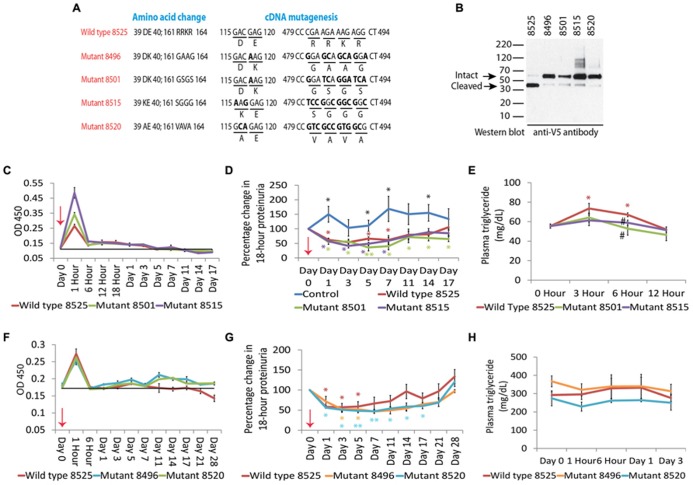FIGURE 5.
(A) Schematic representation of wild type and mutant human Angptl4 proteins showing mutations in areas important for LPL binding (amino acid 40, and adjacent amino acid 39) and protein cleavage (amino acids 161 to 164). (B) Western blot of recombinant tagged proteins using mouse anti V5 antibody to demonstrate the expected size of the intact protein and reduced cleavage in the mutant proteins (arrows). (C) Plasma levels of wild type (8525) or mutant (8501, 8515) human Angptl4 in Buffalo Mna rats (n = 3 rats/group) after injecting 55 μg of recombinant human protein as assessed by OD 450 using reagents from the human Angptl4 ELISA kit. (D) Effect of injecting wild type and mutant Angptl4 on proteinuria in Buffalo Mna rats. (E) Effect of injecting wild type and mutant Angptl4 on plasma triglyceride levels in Buffalo Mna rats. (F) Plasma levels of wild type (8525) and mutant (8496, 8520) human Angptl4 proteins as assessed by OD 450 after injecting a lower dose (15 μg) in Zucker Diabetic Fatty (ZDF) rats (n = 4 rats/group). (G) Effect of injecting wild type and mutant Angptl4 on proteinuria in ZDF rats. (H) Effect of 15 μg of wild type and mutant Angptl4 on plasma triglyceride levels in ZDF rats. Error bars are s.e.m. t-test, two way, *P < 0.05, **P < 0.01. In panel D, black * are shown where all three study groups were individually different from control injected rats. In panels D, e.g., colored * shown where individual values were significantly different from corresponding baseline values. # in panel E is P < 0.05 in mutant protein groups compared to wild type Angptl4 injected rats. Adapted from Clement et al. (2014).

